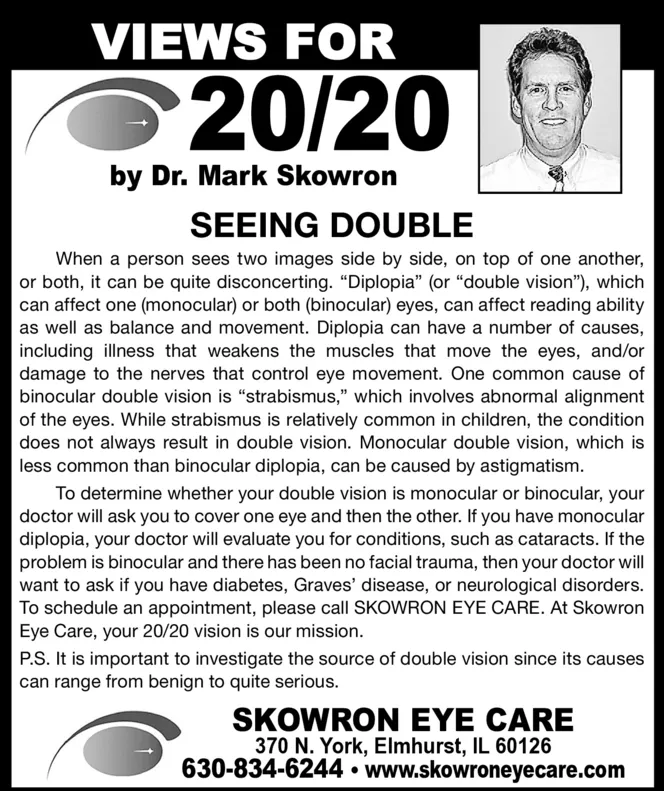Advertisement

-
Published Date
August 5, 2021This ad was originally published on this date and may contain an offer that is no longer valid. To learn more about this business and its most recent offers, click here.
Ad Text
VIEWS FOR O20/20 by Dr. Mark Skowron SEEING DOUBLE When a person sees two images side by side, on top of one another, or both, it can be quite disconcerting. "Diplopia" (or "double vision"), which can affect one (monocular) or both (binocular) eyes, can affect reading ability as well as balance and movement. Diplopia can have a number of causes, including illness that weakens the muscles that move the eyes, and/or damage to the nerves that control eye movement. One common cause of binocular double vision is "strabismus," which involves abnormal alignment of the eyes. While strabismus is relatively common in children, the condition does not always result in double vision. Monocular double vision, which is less common than binocular diplopia, can be caused by astigmatism. To determine whether your double vision is monocular or binocular, your doctor will ask you to cover one eye and then the other. If you have monocular diplopia, your doctor will evaluate you for conditions, such as cataracts. If the problem is binocular and there has been no facial trauma, then your doctor will want to ask if you have diabetes, Graves' disease, or neurological disorders. To schedule an appointment, please call SKOWRON EYE CARE. At Skowron Eye Care, your 20/20 vision is our mission. P.S. It is important to investigate the source of double vision since its causes can range from benign to quite serious. SKOWRON EYE CARE 370 N. York, Elmhurst, IL 60126 630-834-6244 www.skowroneyecare.com VIEWS FOR O20/20 by Dr. Mark Skowron SEEING DOUBLE When a person sees two images side by side, on top of one another, or both, it can be quite disconcerting. "Diplopia" (or "double vision"), which can affect one (monocular) or both (binocular) eyes, can affect reading ability as well as balance and movement. Diplopia can have a number of causes, including illness that weakens the muscles that move the eyes, and/or damage to the nerves that control eye movement. One common cause of binocular double vision is "strabismus," which involves abnormal alignment of the eyes. While strabismus is relatively common in children, the condition does not always result in double vision. Monocular double vision, which is less common than binocular diplopia, can be caused by astigmatism. To determine whether your double vision is monocular or binocular, your doctor will ask you to cover one eye and then the other. If you have monocular diplopia, your doctor will evaluate you for conditions, such as cataracts. If the problem is binocular and there has been no facial trauma, then your doctor will want to ask if you have diabetes, Graves' disease, or neurological disorders. To schedule an appointment, please call SKOWRON EYE CARE. At Skowron Eye Care, your 20/20 vision is our mission. P.S. It is important to investigate the source of double vision since its causes can range from benign to quite serious. SKOWRON EYE CARE 370 N. York, Elmhurst, IL 60126 630-834-6244 www.skowroneyecare.com
